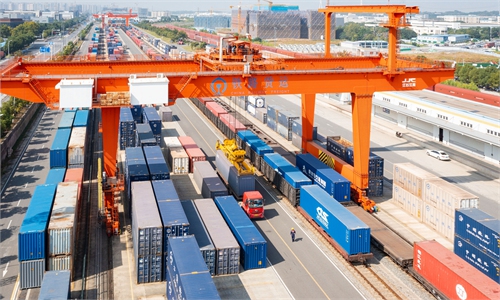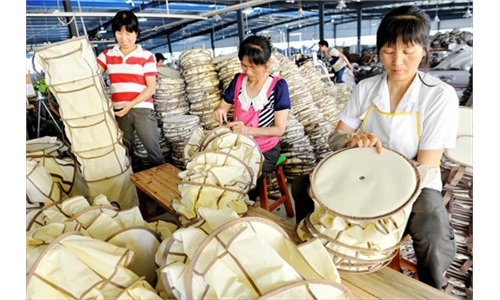China’s robust economic recovery stimulated by fiscal policy and consumption rebound

Bustling scenes on Nanjing Road, East China's Shanghai Municipality on September 14, 2023 Photo: VCG
On November 15, the National Bureau of Statistics released economic data for October. The added value of industries above designated size increased by 4.6 percent year-on-year, accelerated by 0.1 percentage points over the previous month. Total retail sales of consumer goods amounted to 4.33 trillion yuan ($600 billion), an increase of 7.6 percent year-on-year, accelerated by 2.1 percentage points from the previous month. The newly released data shows that China's major economic indicators continue to improve, and the national economy continues to recover.Not long ago, after completing its Article IV Consultation mission to China in 2023, the International Monetary Fund (IMF) raised its GDP growth forecasts for China to 5.4 percent in 2023 and 4.6 percent in 2024. As for the reason, "One is the third quarter GDP growth came up, came out stronger than we expected, and it was importantly driven by stronger consumption than we had expected. The second reason is the additional fiscal stimulus that was recently announced, that is raising growth for this year and for next", stated Ms. Gita Gopinath, the IMF's First Deputy Managing Director.
On the one hand, the market's long-awaited fiscal stimulus has landed. Two trillion-dollar fiscal stimulus packages have been implemented since October. There have been 27 provincial-level regions disclosing the proposed issuance of special refinancing bonds, the issuance or proposed issuance amount totaling more than 1.2 trillion yuan for the repayment of government debt. Guizhou, Yunnan, and Inner Mongolia among other provincial-level regions plan to issue special refinancing bonds exceeding 100 billion yuan, media outlet yicai.com reported. The Ministry of Finance stated that it would start the issuance of a trillion yuan of additional treasury bonds to support post-disaster restoration and reconstruction and enhance the disaster prevention, mitigation, and relief capacity. With additional special treasury bonds, China's government indebtedness is still in a reasonable range. While triggering some people's concerns, continuous fiscal stimulus boosted market confidence.
From January to October, fixed-assets investment amounted to 41.9 trillion yuan, a growth of 2.9 percent year-on-year. Fixed-asset investment in the private sector declined by 0.5 percent year-on-year, while the rate narrowed by 0.1 percentage points. The growth rate of private investment, excluding investment in real estate development, increased to 9.1 percent. The growth rate of value added by private industrial enterprises increased to 3.9 percent from last year's lowest point.
Since the second half of this year, China has continued to promote the development of the private economy. On July 19, the Communist Party of China Central Committee and the State Council issued the "Opinions on Promoting the Development and Strengthening of the Private Economy," which once again affirmed the vital role of the private economy. On September 4, the National Development and Reform Commission established the Bureau for the Development of the Private Economy to promote the development of the private economy and to enhance the coordination of the policies in related areas. Since then, various departments have issued relevant policies. The private economy may become a new engine for economic development.
For the first three quarters, investment in high-tech manufacturing and services grew by 11.3 percent and 11.8 percent year-on-year, respectively, 8.2 and 8.7 percentage points higher than the growth rate of all fixed-asset investments. This indicates that China's innovation momentum has been increasing, which is favorable to the long-term development of the economy.
On the other hand, consumption increased significantly. Total retail sales of consumer goods grew at a year-on-year rate of 7.6 percent in October, accelerated by 2.1 percentage points from the previous month. This will undoubtedly inject new momentum into economic growth. According to the Bureau of Statistics, the national consumer confidence index gradually rose since the second half of the year. In September, China's consumer confidence index stood at 87.2, 0.7 points higher than that of the previous month.
Significant heterogeneity exists among consumer markets in different regions of China, contributing to the continuous growth in consumption. Currently, high-end consumer demand for quality of life, leisure, and entertainment mainly concentrates on first- and second-tier cities. As urbanization and rural revitalization advance in small towns and rural areas, the demand of these broader groups of consumers is expected to support China's consumption in the aggregate.
In addition, rising preferences for Chinese "domestic products" continue to drive the growth of local brands. A number of reasons drive this. On the demand side, the more complex international situation has led more consumers to choose to support local brands in global competition. On the supply side, as China's industrial upgrading process advances, more local products become more competitive. Also, local brands tend to be more integrated with new channels such as e-commerce platforms and live streaming.
Increased investment and consumption will benefit not only the Chinese economy but also the world economy. As the world's largest consumer market and the second-largest importer, the robust recovery of China's economy will directly contribute to the growth of global goods and services through economic activities such as importing goods, traveling abroad, and studying abroad.
An Zidong is an associate professor at the School of Applied Economics under Renmin University of China and a former senior researcher at the International Monetary Fund. Li Haibo is a PhD student at the School of Applied Economics under Renmin University of China. bizopinion@globaltimes.com.cn



